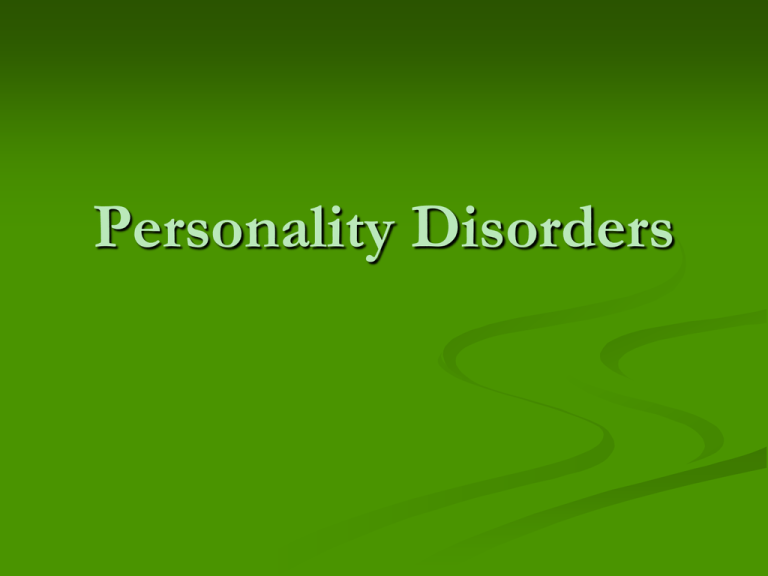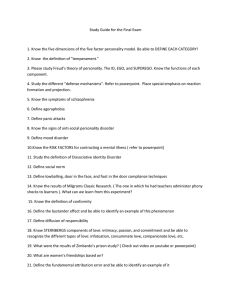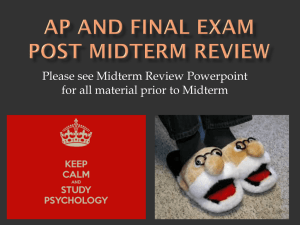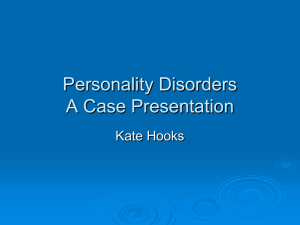Personality Disorders
advertisement

Personality Disorders Personality Disorders- Axis II (less serious than Axis I disorders Personality disorders – psychological disorders characterized by inflexible and enduring behavior patterns that impair social functioning. Generally less serious than the other psychological disorders (Axis II) Types of Personality Disorders Cluster A (Odd and Eccentric Cluster) Cluster B (Dramatic, Emotional, Erratic Cluster) Cluster C (Anxious and Fearful Cluster) Odd and Eccentric Cluster Paranoid Personality Disorder – patient displays a pattern of persistent distrust and suspiciousness of others Disorder is diagnosed by early adulthood Patient has the belief that others are out to exploit or harm them without evidence that this is true Preoccupied thoughts of others lack of loyalty Reluctant to confide in others Disorder may be apparent in childhood and teenage years – social anxiety, poor school performance, peculiar thoughts and language, hypersensitivity More commonly diagnosed in males Prevalence - .5 – 2.5% Odd and Eccentric Cluster Schizoid Personality Disorder – person is socially withdrawn and lacks feelings for others Lack the desire for intimacy and to develop close relationships Little satisfaction from social/family gatherings Choose solitary hobbies where no interaction is required Patients are not concerned with the acceptance of approval of others Rarely give facial expressions or gestures (ex. failing to smile at something funny or nod with approval) Difficult time expressing anger Those with schizoid personality disorder do not marry or have close relationships Diagnosed slightly more often in males Dramatic, Emotional, Erratic Cluster Antisocial Personality Disorder (formerly called a psychopath/sociopath) – a personality disorder in which the person, usually a man, exhibits a lack of conscience for wrongdoing, even toward family members and friends. Inability to empathize with others..pattern of violent, criminal, exploitative or unethical behavior. May be aggressive and ruthless or a clever con artist Antisocial personality disorder is the most well-known and most important personality disorder Begins in childhood and continues into adulthood Read about Henry Lee Lucas on page 654 in Myers Those with APD, have less frontal lobe cognitive functions Age 3-6 child is impulsive, uninhabited, unconcerned with social rewards, displays low anxiety levels. Lack of planning, organizing and inhibition 3% of men and 1% of women in the US are diagnosed with APD Charles Manson interview in San Quentin Prison - YouTube Antisocial Personality Disorder - The Low-Level Psychopath (Direct Action & Less Manipulative) – YouTube Dramatic, Emotional, Erratic Cluster Borderline Personality Disorder – A personality disorder in which one has an unstable self image, moods, relationships and has a fear of abandonment. Found in about 2% of the general population. Diagnose in predominantly women (75%) What is Borderline Personality Disorder? (Mental Health Guru) - YouTube Dramatic, Emotional, Erratic Cluster Narcissistic Personality Disorder – A personality disorder in which one exaggerates self-importance and achievements and needs constant admiration. Personality appears exceedingly arrogant. These individuals have the expectation that others see them as superior or unique These individuals lack empathy. Envious of others or believe that others are envious of them Display snobbish or patronizing attitude. Narcissistic Personality Disorder; The Social Network How To Spot Narcissists On Facebook Narcissism The Female Narcissist - YouTube Dramatic, Emotional, Erratic Cluster Histrionic Personality Disorder – pervasive and excessive emotionality and attention-seeking behaviors. Uncomfortable when they are not the center of attention Appearances is often sexually provocative Emotional expression is shallow Easily influenced by others and by current fads histrionic personality disorder - YouTube Anxious and Fearful Cluster Avoidant personality disorder – A personality disorder in which one is irrationally fearful of rejection leading to isolation. General Population prevalence - .5 – 1% Often evident in childhood – shyness, isolation, fear of new situations Shyness increases during adolescence Avoidant Personality Disorder YouTube Anxious and Fearful Cluster Dependent Personality Disorder – A personality disorder in which one has difficulty making decisions, are passive, dependent and helpless. These individuals are preoccupied with the fear of being alone and left to care for themselves. This is the most frequently reported personality disorder True Life Im Dependent - YouTube Anxious and Fearful Cluster Obsessive Compulsive Personality Disorder – a preoccupation with orderliness, perfection and control exist. Excessively careful and prone to repetition So involved in detail, they may not finish a project Obsessed with work, exclude leisure Reluctant to delegate tasks Controlling, inflexible, excessively conscientious Different from Ob-Com Disorder (where specific obsessions and compulsions are evident and thus leading to anxiety) Anxious and Fearful Cluster Passive - Aggressive Personality Disorder – People with this disorder will covertly (secretively) commit an aggressive act against others behind their back while smiling and being friendly in their presence. VIEW: Featured Article: The PassiveAggressive Personality. Mother on Everybody Loves Raymond Passive Aggressive Anger - YouTube






